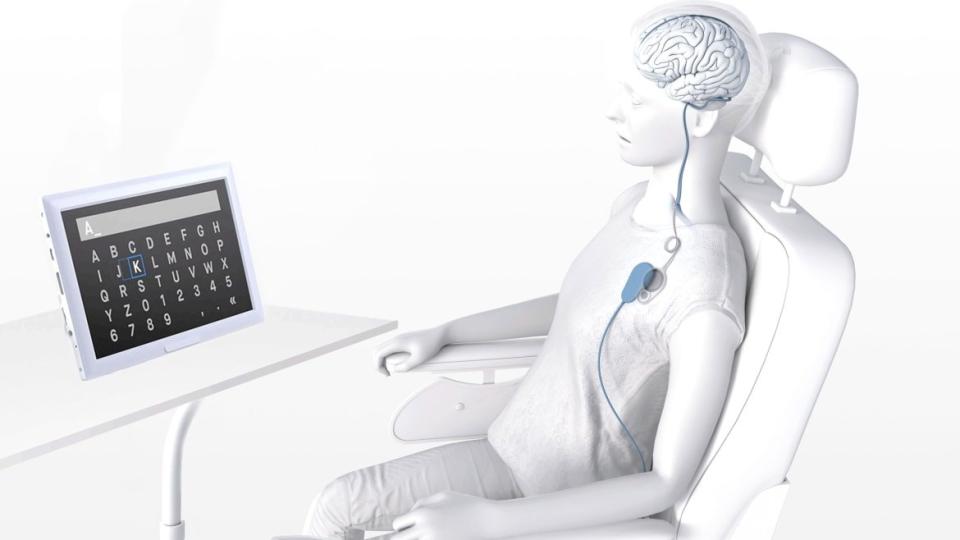This New Implant Hacks the Brain by Going Through Your Chest

Thanks to the success of an initial safety trial for an implantable device that can translate the brain’s electrical impulses into readable signals, we’re a step closer to being able to text—or otherwise interface with our devices—using just our thoughts.
Best of all, this new brain-computer interface (BCI)—“brain modem,” if you will—doesn’t require a hole in your head. It does, however, require a hole in your chest. And that’s just one factor that could slow development of the tech, to say nothing of complicating any future public rollout.
Brain modems are coming, whether they’ll be delivered by Elon Musk’s Neuralink company, or some other group . But how fast they’ll be ready, how well they’ll work, and how many people will want them are all big open questions.
Late last month, New York-based biotech company Synchron announced the results of a trial of its two-piece brain modem in four people with amyotrophic lateral sclerosis, or ALS—a progressive neurodegenerative disease that affects the brain and spinal cord and can lead to paralysis. It was the first time the U.S. Food and Drug Administration had approved a BCI for clinical trials.
“It’s going to provide the potential for millions of patients to have improved abilities to interact with their environment and therefore have a higher quality of life,” J Mocco, a neurosurgeon and Synchron consultant, told The Daily Beast.

Testers monitored the four volunteers for a year, looking for any negative effects from the implants. There were “no serious adverse events that led to disability or death,” the company announced. Synchron’s team published their results in the Journal of NeuroInterventional Surgeries.
The implants weren’t just safe, according to Synchron. They worked too—at least on a rudimentary level. The devices “allowed participants to use a computer to communicate by text and perform daily tasks such as online shopping and banking.”
That might sound like science fiction, but the idea is pretty straightforward. Our brains move around information via subtle electrical impulses. Our thoughts, in other words, are electricity. And they flash in recognizable patterns. Put a sensor in the brain, and it can read the patterns. Connect that sensor to a radio transmitter, and you can literally beam your thoughts to a compatible device the same way phones connect to phones or your computer connects to WiFi.
The applications are obvious, especially for paralyzed people. With a safe, effective brain modem, you wouldn’t need to move or even speak in order to send a text, browse the internet or interact with any number of electronic devices.
All you’d have to do is think—and let the modem do the work.

There are problems, of course. For starters, the earliest brain modems were combination sensors and transmitters that researchers implanted directly into people’s skulls. Whenever you’re drilling into someone’s skull, the risk of infection, inflammation, and brain damage are significant. “Intracranial surgery will always be a risky part of invasive BCI procedures,” Chris Crawford, head of the Human-Technology Interaction Lab at the University of Alabama, told The Daily Beast.
Not to mention, it’s scary. If the goal is to first help millions of people who suffer some degree of paralysis, and then eventually offer brain modems to the general public, drilling holes in heads is an obvious non-starter. Crawford cited “public perception of BCI” as “the next obstacle.”
The solution to the hole-in-the-head problem came by way of cardiac medicine. It’s becoming more common for heart surgeons to treat blockages without operating anywhere near the heart or making any big incisions at all. Instead, they make a small cut in the groin or wrist and insert a collapsed mesh tube, potentially just a few centimeters in length, into an artery. This “stent” acts like scaffolding. Expanded electrically, a stent lodges in a blood vessel near the heart, where it keeps blood flowing past a blockage.
Neurosurgeons have begun adapting stent tech for their latest brain-modem designs. As the first company to get the FDA nod for a clinical trial, Synchron is arguably the leader in this field.
Start with a stent. Add a layer of electrical sensors to the mesh, producing a combination electrode and stent that developers call a “stentrode.” Inject it into an artery in the neck and lodge it in one of the blood vessels inside your skull. From there, it senses the impulses in your brain—without ever touching it. “It does not directly violate the brain,” Mocco stressed.

Now here’s the tricky part. The stentrode needs some way to get a signal out of the body. Bone, especially thick bone like the skull, tends to block radio signals—hence the hole-in-the-head approach that was typical with the first generation of experimental BCIs.
But there are parts of the body with no bones. The chest between your ribs, for example. Synchron got around the skull problem by implanting its transmitter in the chest and connecting it, via a fine wire under the skin, to the stentrode in the brain.
That combo—a sensor in the brain and a coin-size transmitter in the chest—is Synchon’s special sauce. It’s potentially non-invasive enough that a lot of people would be willing to get it implanted. “This has potential to be an out-patient procedure,” Mocco said.
And even if people still balk at a chest implant, at least they won’t balk as hard as they would when staring down a bone-drill aiming at their skull. Synchron’s stentrode-and-chest-transmitter combo “may be a good compromise,” Marvin Andujar, the lab director at the University of South Florida’s Neuro-Machine Interaction Lab, told The Daily Beast.
Synchron’s tech is winning over some experts in the field, even ones who are skeptical of implanted devices. Crawford thinks attitudes will change as stentrodes replace riskier skull-transmitters. “As long as safety is being considered first, marketability, and effectiveness will eventually improve over time,” he said.

No one is pretending there’s not a lot of work left to do. The Synchon device might be safe, if a yearlong trial with just four people is any indication. But safe isn’t the same as useful.
This first stentrode from Synchron allows for only very limited interaction with devices. A BCI implanted in the skull can accurately transmit just 90 text characters per minute. The equivalent of typing a single sentence in 60 seconds. That’s not fast. The Synchron device with its chest transmitter is even slower. The best result from the recent trials was 20 characters per minute. A sentence every four minutes or so.
BCIs need to get faster and less invasive. Ultimately, a brain modem should be “fashionable, not weird-looking” and also “robust and safe at the same time,” Andujar said. The perfect version is totally non-invasive—a cap you wear on your head. Sensors in the lining read your thoughts. Transmitters on the same cap link with your devices. Your thoughts spill onto your screens at the rate you think them.
But that ideal brain modem is just a dream for now. Today’s tech still requires some way of getting little spurts of data through, or around, our bones. Synchron is the leader in stentrode brain modems and it’s only just begun testing its device. “Additional trails over longer time periods will be needed to continue progress,” Crawford said.
Still, even a small-scale safety trial of a compromise device with middling effectiveness results is a big step for a tech that could, with time and refinement, make so many lives so much better.
Next up for Synchron: a bigger trial—one that Mocco said will focus on “maximizing efficacy.” That is, making more devices work better when all the user can do is think at them. For starters, they need to be able to output more than a few words per minute. After all, our thoughts move a lot faster than that.
Got a tip? Send it to The Daily Beast here
Get the Daily Beast's biggest scoops and scandals delivered right to your inbox. Sign up now.
Stay informed and gain unlimited access to the Daily Beast's unmatched reporting. Subscribe now.

